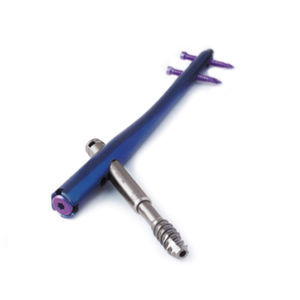
Humeral intramedullary nail 3.2383.180titanium
Add to favorites
Compare this product
Characteristics
- Joint / bone
- humerus
- Materials
- titanium
- Length
Min.: 150 mm
(5.9 in)Max.: 320 mm
(12.6 in)
Description
- Instrument set for implant insertion and removal when the treatment has been completed,
- Instructions for use (surgical technique).
Intramedullary osteosynthesis of humerus provides stable fixation in the following cases:
- comminuted fractures of the shaft of the humerus,
- severe closed and open fractures of I degree,
- pathological fractures, mal-union or non-union of the fragments of the humeral shaft after treatment using other methods.
Static method
Static fixation is used in multi-fragmental fractures with non-axial stability of bone fragments.
Use holes in the distal part of the nail, and one round or both holes - round and oval-shaped - in the proximal part to lock the nail statically.
Dynamic method
Dynamic fixation may be used in the case of good cortex contact of bone fragments in transverse and oblique fractures, as well as in pseudoarthroses. All distal holes and one oval-shaped proximal hole of the i ntra medullary humeral nail are used in that fixation.
Dynamic fixation enables axial movement of bone fragments while loading the limb. In this way, a physiological stimulus is formed to create to create callus and transform it into the lamellar bone.
Dynamic method with compression
In dynamic fixation with compression (compressive fixation) the compression screw shall be axially inserted into internal threaded hole of the nail shaft in order to put pressure on the screw that locks the nail. The compressive fixation eliminates all micro-movements in the initial stage of fracture treatment.
Catalogs
Intramedullary nails
121 Pages
Related Searches
- Bone plate
- Compression plate
- Metallic compression plate
- Locking compression plate
- Titanium compression plate
- Distal compression plate
- Compression bone screw
- Metallic compression bone screw
- Interbody fusion cage
- Orthopedic surgery surgery set
- Proximal compression plate
- Forearm compression plate
- Mid-shaft compression plate
- Arthrodesis nail
- Lateral compression plate
- Tibia compression plate
- Radius compression plate
- PEEK interbody fusion cage
- Humeral compression plate
- Metallic intramedullary nail
*Prices are pre-tax. They exclude delivery charges and customs duties and do not include additional charges for installation or activation options. Prices are indicative only and may vary by country, with changes to the cost of raw materials and exchange rates.


















